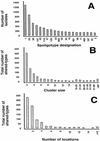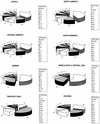Snapshot of moving and expanding clones of Mycobacterium tuberculosis and their global distribution assessed by spoligotyping in an international study
- PMID: 12734235
- PMCID: PMC154710
- DOI: 10.1128/JCM.41.5.1963-1970.2003
Snapshot of moving and expanding clones of Mycobacterium tuberculosis and their global distribution assessed by spoligotyping in an international study
Abstract
The present update on the global distribution of Mycobacterium tuberculosis complex spoligotypes provides both the octal and binary descriptions of the spoligotypes for M. tuberculosis complex, including Mycobacterium bovis, from >90 countries (13,008 patterns grouped into 813 shared types containing 11,708 isolates and 1,300 orphan patterns). A number of potential indices were developed to summarize the information on the biogeographical specificity of a given shared type, as well as its geographical spreading (matching code and spreading index, respectively). To facilitate the analysis of hundreds of spoligotypes each made up of a binary succession of 43 bits of information, a number of major and minor visual rules were also defined. A total of six major rules (A to F) with the precise description of the extra missing spacers (minor rules) were used to define 36 major clades (or families) of M. tuberculosis. Some major clades identified were the East African-Indian (EAI) clade, the Beijing clade, the Haarlem clade, the Latin American and Mediterranean (LAM) clade, the Central Asian (CAS) clade, a European clade of IS6110 low banders (X; highly prevalent in the United States and United Kingdom), and a widespread yet poorly defined clade (T). When the visual rules defined above were used for an automated labeling of the 813 shared types to define nine superfamilies of strains (Mycobacterium africanum, Beijing, M. bovis, EAI, CAS, T, Haarlem, X, and LAM), 96.9% of the shared types received a label, showing the potential for automated labeling of M. tuberculosis families in well-defined phylogeographical families. Intercontinental matches of shared types among eight continents and subcontinents (Africa, North America, Central America, South America, Europe, the Middle East and Central Asia, and the Far East) are analyzed and discussed.
Figures



References
-
- Caminero, J. A., M. J. Pena, M. I. Campos-Herrero, J. C. Rodriguez, I. Garcia, P. Cabrera, C. Lafoz, S. Samper, H. Takiff, O. Afonso, J. M. Pavon, M. J. Torres, D. van Soolingen, D. A. Enarson, and C. Martin. 2001. Epidemiological evidence of the spread of a Mycobacterium tuberculosis strain of the Beijing genotype on Gran Canaria island. Am. J. Respir. Crit. Care. Med. 164:1165-1170. - PubMed
-
- Dale, J. W., D. Brittain, A. A. Cataldi, D. Cousins, J. T. Crawford, J. Driscoll, H. Heersma, T. Lillebaek, T. Quitugua, N. Rastogi, R. Skuce, C. Sola, D. van Soolingen, and V. Vincent. 2001. Spacer oligonucleotide typing of Mycobacterium tuberculosis: recommendations for standardized nomenclature. Int. J. Tuberc. Lung. Dis. 5:216-219. - PubMed
-
- Filliol, I., J. R. Driscoll, D. van Soolingen, B. N. Kreiswirth, K. Kremer, G. Valétudie, D. D. Anh, R. Barlow, D. Banerjee, P. J. Bifani, K. Brudey, A. Cataldi, R. C. Cooksey, D. V. Cousins, J. W. Dale, O. A. Dellagostin, F. Drobniewski, G. Engelmann, S. Ferdinand, D. Gascoyne-Binzi, M. Gordon, M. C. Gutierrez, W. H. Haas, H. Heersma, G. Källenius, E. Kassa-Kelembho, T. Koivula, H. M. Ly, A. Makristathis, C. Mammina, G. Martin, P. Moström, I. Mokrousov, V. Narbonne, O. Narvskaya, A. Nastasi, S. N. Niobe-Eyangoh, J. W. Pape, V. Rasolofo-Razanamparany, M. Ridell, M. L. Rossetti, F. Stauffer, P. N. Suffys, H. Takiff, J. Texier-Maugein, V. Vincent, J. H. de Waard, C. Sola, and N. Rastogi. 2002. Global distribution of Mycobacterium tuberculosis spoligotypes. Emerg. Infect. Dis. 8:1347-1349. - PMC - PubMed
Publication types
MeSH terms
Substances
LinkOut - more resources
Full Text Sources

